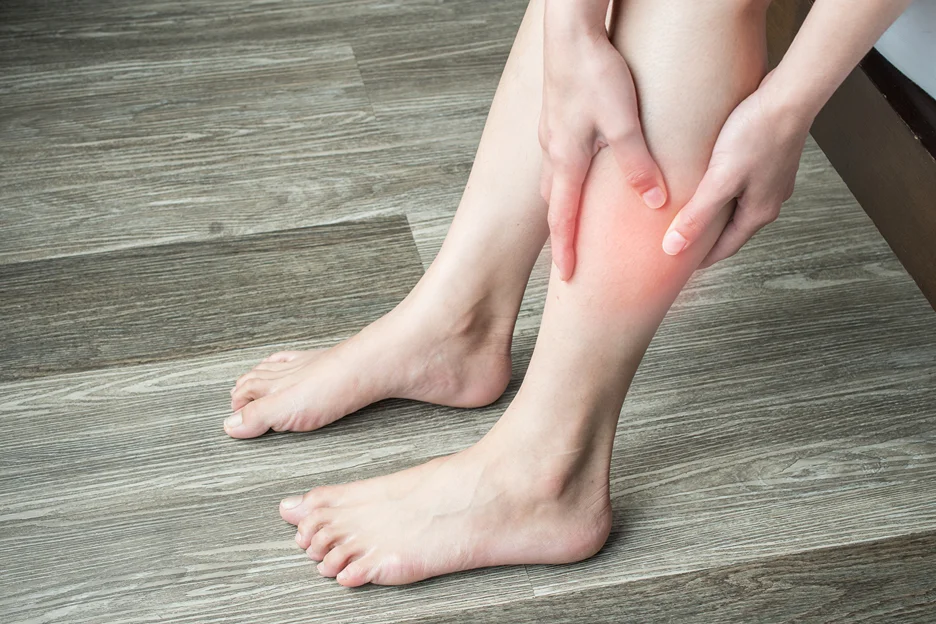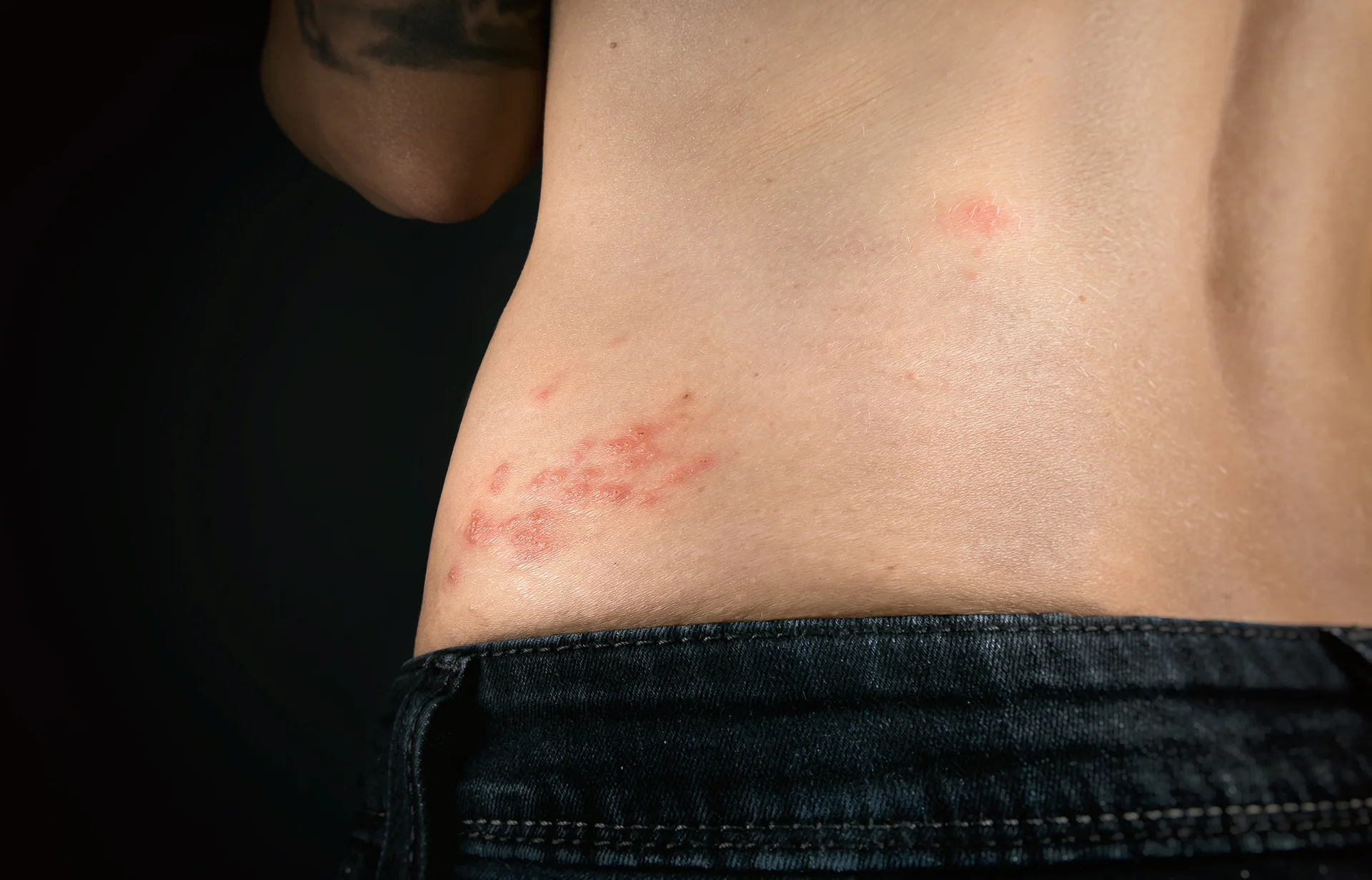Here at Kaly, we understand how debilitating chronic back pain can be. Many of the people that we know and love suffer from sciatica – that sharp, shooting nerve pain that radiates from your lower back down through your butt and leg. For some, this chronic condition is made even worse by a case of shingles.
What is the connection between shingles and sciatica?
Shingles and sciatica refer to two distinct medical conditions that are caused by different underlying factors, yet often coincidentally overlap.
Sciatica is characterized by radiating pain that runs along the sciatic nerve, which extends from the lower back down through the buttocks and legs. It is often caused by a herniated disc or bone spur compressing the sciatic nerve.
Shingles, on the other hand, results from a reactivation of the varicella-zoster virus that causes chickenpox. After a childhood infection, the virus lies dormant in the body’s nerve fibers. When reactivated due to age, stress, or immunocompromisation, it travels along the nerve routes causing an incredibly painful rash known as shingles.
For some individuals, this reactivated virus makes its way specifically down the sciatic nerve, resulting in inflamed nerve pain that mirrors sciatica.
Does the herpes zoster virus cause both shingles and sciatica?

The varicella-zoster virus is the underlying cause of shingles, but not sciatica itself.
So when a shingles infection occurs along the sciatic nerve, it can trigger or exacerbate sciatic nerve pain and sensations. The virus does not damage the actual sciatic nerve structure, but rather inflames the nerve as it replicates down the sciatic nerve pathway. This inflamed nerve root mimics classic sciatica in terms of radiating pain, numbness, and tingling sensations down the leg.
What distinguishes the symptoms of shingles-related sciatica from other types of sciatica?
The main distinguishing symptom of sciatica induced by a shingles infection is the presence of a blistery, painful shingles rash located along the sciatic nerve track.
Typical symptoms of standalone sciatica relate to nerve pain radiating from the lower back down the leg, often described as sharp, shooting pain or numbness. Without shingles, there is no rash present.
With shingles-related sciatica, the nerve pain is accompanied by a red, burning rash consisting of fluid-filled blisters along the path of the sciatic nerve. The rash usually only affects one side of the body and is preceded by 2-3 days of localized pain before the blisters emerge. Unlike typical sciatica, the pain may fluctuate in intensity and sensation. It is often described as tingling, stabbing, or electric shock-like pain rather than the dull ache of traditional sciatica.
How are healthcare providers able to differentiate between shingles-induced sciatica and other types of sciatica during diagnosis?
Your physician has an arsenal of tools at their disposal to get to the root cause of your sciatic pain:
- Medical History – They’ll inquire about recent shingles outbreaks and closely review your health history for any clues.
- Physical Exam – Doctors check for lingering shingles rashes, skin sensitivity, muscle weakness, and reduced reflexes indicating nerve damage.
- Imaging – MRI or CT scans can detect nerve inflammation related to shingles versus a herniated disc putting pressure on the sciatic nerve.
- Lab Tests – Cerebrospinal fluid tests can confirm the presence of varicella zoster antibodies related to shingles.
- Nerve Conduction Studies – EMG tests measure how well nerves are conducting signals and can aid in diagnosing nerve inflammation.
The combination of a thorough review of your medical history, targeted physical examination, and diagnostic testing enables physicians to discern whether a recent case of shingles is the perpetrator behind your sciatic pain.
Can internal shingles manifest symptoms that mimic sciatica, and how is it diagnosed?

It’s sneaky, but yes – shingles can strike internally along the sciatic nerve without ever erupting into a telltale painful skin rash. This is known as internal or zoster sine herpete.
Without the blistery shingles lesions, it’s easy to misattribute the nerve pain to routine sciatica.
However, your doctor may pick up on subtle hints that point to underlying shingles, such as:
- Stabbing, burning unilateral pain – More agonizing than typical sciatica discomfort.
- Allodynia – Heightened sensitivity to touch near the sciatic nerve.
- Flu-like fever or malaise – Signs of viral inflammation.
- Tingling or weakness in leg/foot – Reflect nerve inflammation.
- Previous bouts of shingles – Increased risk of recurrence.
Blood tests and a spinal tap to check for varicella zoster antibodies can also confirm shingles as the cause of what initially seems like generic sciatica. Don’t hesitate to mention your suspicion of internal shingles to your provider.
What are the implications for physical therapy and rehabilitation when dealing with sciatica caused by shingles?
Recovery from shingles-related sciatica relies heavily on physical rehabilitation to retrain proper nerve functioning, flexibility, and core strength.
Since the sciatic pain arises from viral inflammation rather than true nerve damage, physical therapists can employ modalities like transcutaneous electrical nerve stimulation (TENS), therapeutic ultrasound, hot/cold packs, and soft tissue massage to calm irritation and spasms around the sciatic nerve root.
Gentle stretching will help loosen tense muscles contributing to nerve compression. Carefully tailored exercises strengthen abdominal and low back muscles to take pressure off the sciatic nerve. Aerobic activity facilitates healing by increasing blood flow.
But it’s important to note that overexertion must be avoided to prevent flare ups. A gradual, paced reconditioning program designed by a physical therapist can aid recovery after sciatica triggered by shingles.
Can a previous shingles infection increase the risk of developing sciatica later on?
Yes, a bout of shingles does raise your risk of experiencing chronic sciatica at some point in the future.
The inflammation caused by the herpes zoster virus can lead to scarring around the sciatic nerve. This damage then predisposes the area to increased compression that precipitates classic sciatic pain.
Shingles survivors are also at elevated risk of postherpetic neuralgia, or lingering neuropathic nerve pain long after the rash heals. This chronic pain condition frequently involves the sciatic distribution.
Additionally, the immune system changes prompted by a shingles infection may increase susceptibility to a subsequent back injury or disc herniation that impinges the sciatic nerve. Thus, those recovering from sciatica due to shingles should take precautions to protect their spine health.
What precautions should individuals with sciatica take to reduce the risk of developing shingles?

If you already suffer from sciatic pain unrelated to shingles, it’s wise to take proactive precautions to avoid the varicella zoster virus flaring up along your sciatic nerve. Strategies to minimize shingles risk include:
| Precaution Strategy | Description |
| Get Vaccinated | The shingles shot provides the best protection against the virus affecting your sciatic nerve. |
| Boost Immunity | Strengthen your immune system by eating healthy, exercising regularly, and getting sufficient sleep. |
| Manage Stress | Reduce chronic stress through relaxation techniques, as it can weaken your immune system and increase the risk of shingles. |
| Treat Other Health Issues | Be proactive in managing other conditions like diabetes, cancer, and autoimmune disorders that can make you more susceptible to shingles. |
| Avoid Skin Contact | Stay away from direct contact with open shingles lesions to prevent the spread of the virus. |
| Know the Signs | Early detection of shingles can reduce the severity and prevent nerve complications such as sciatic pain. |
By following these strategies, individuals with sciatica can reduce their risk of developing shingles and potentially avoid further complications affecting the sciatic nerve.
How can shingles along the sciatic nerve impact a person’s mobility and quality of life?
Suffering from concurrent shingles and sciatica inflammation can significantly reduce mobility and normal daily functioning. The intense pain makes it difficult to carry out normal activities like standing, walking, bending, sitting, or lifting. The rash and blisters compound the pain and mobility challenges.
Everyday tasks like grooming, cooking, cleaning, and self-care become arduous. It may require relying on others for assistance. Ability to exercise or enjoy recreational activities is impaired during flare ups. Work and career productivity can decline due to pain and absenteeism. Driving or traveling can be affected.
Overall quality of life is reduced, potentially leading to emotional difficulties like depression, anxiety, anger, and social isolation. Counseling and support groups can help cope with the psychological aspects. Gentle movement, pacing activities, proper rest, and pain management are imperative for minimizing the impacts during a shingles-sciatica flare up.
The Takeaway

We hope this breakdown has helped enlighten you on the intricate relationship between shingles and sciatica – two distinct conditions that are intrinsically interlinked. The varicella zoster virus can inflict immense damage along the sciatic nerve, resulting in acute sciatic pain and potential long-term impairment.
While the path to recovery when simultaneously battling shingles and sciatica can be long and challenging, the range of medical treatments, alternative therapies, and holistic lifestyle measures covered here provide a valuable toolkit. Arm yourself with the knowledge to recognize the symptoms early, seek proper diagnosis, and understand the nuances of your treatment options.
We know firsthand how shingles and sciatica can derail daily life, but the Kaly team is here for you every step of the way. Reach out with any questions as you navigate this difficult process.
With compassion and care from your community, you can overcome the pain and reclaim your freedom of movement. The future is bright!
